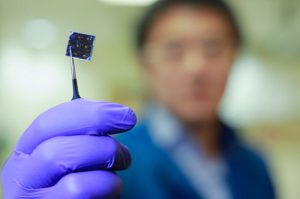Materials scientists from the UCLA Samueli School of Engineering have developed a powerful thin-film solar cell that generates more energy from sunlight than average solar panels, as a result of its double-layer design, according to UCLA.
The device is made of an inexpensive compound of lead and iodine, known as perovskite, that has proven to be very efficient at capturing energy from sunlight. A thin layer of the perovskite is sprayed onto a commercially available solar cell, while the solar cell that forms the bottom layer of the device is made of a compound of copper, indium, gallium and selenide, or CIGS, creating a new cell that successfully converts 22.4 percent of the incoming energy from the sun, versus the previous record of 10.9 percent by a group at IBM’s Thomas J. Watson Research Center in 2015.
Yang Yang, UCLA’s Carol and Lawrence E. Tannas Jr. Professor of Materials Science and lead researcher, says this technique of spraying on a layer of perovskite could be easily and inexpensively incorporated into existing solar-cell manufacturing processes.
“Our technology boosted the existing CIGS solar cell performance by nearly 20 percent from its original performance,” says Yang. “That means a 20 percent reduction in energy costs.”
And it will only get better, according to Yang, who says the devices two-layer design could eventually approach 30 percent power conversion efficiency; a goal the research group is currently working towards making a reality.
The UCLA research team aren’t the only ones pushing solar cell technology to new heights. Scientists and engineers from around the world will come together at AiMES 2018 to discuss their work and the future of energy technology from September 30–October 4, 2018. ECS meetings offer researchers the opportunity to come together, share results, and discuss ideas in the field, as well as a multitude of other disciplines, all within the electrochemical and solid state sciences. Meet the innovators of today and leaders of tomorrow this fall. Don’t miss it.


